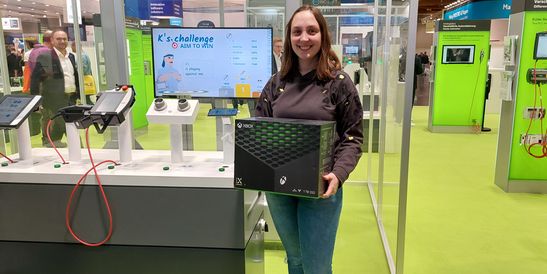6 deficits in the conceptualization of HMI operation devices, and how to do better
- HMI
- 3.2.2022
- Reading Time: {{readingTime}} min
- Share Article

Contents
Development cycles are becoming ever shorter and the pressure to innovate intensifies. Everybody wants to be a trendsetter; nobody just wants to jump on the bandwagon. But where should the quest for innovation start?
We have assembled a list of six deficits that you should be aware of – and avoid where possible – when conceptualizing your next-generation mobile and stationary HMI operation devices. This list can help you create a unique selling point for your industrial HMI operation devices and stand out from the competition.
#1: You start with the visual HMI design – and everybody is an expert
In a large-scale project for the redevelopment of an operation device, many start with the tangible end product: We talk about the hardware, the user interface, optional buttons, multitouch, and even about the design and color of the icons. That is hardly surprising because when it comes to design, practically anybody who has ever held an operation device, perhaps just their smartphone, will have something to say.
However, sometimes it can be better if not everybody has something to say, and this is certainly the case when it comes to innovative concepts for machine operation. It’s like with painting where the primer must always come first – for the HMI, this foundation is the operation concept on which the tangible end design will be created much later. The first step is to adhere to the correct structure and to clarify what the goals of the new HMI are, which features it must accommodate, and which technology specifications it must fulfill. This analysis is then used to derive the operation concept, taking the design aspects into consideration.
#2: You stick with the tried-and-true and fail to ensure an open technology architecture
Are you an Android or an Apple person when choosing a smartphone, or is it just a question of “philosophy” like it is with operating systems? While that is how you might buy a new smartphone or laptop, the situation is not quite as simple when we’re dealing with a new operating concept.
The decision for the technology sets the course for future developments and forms the foundation for sustainable business models. This makes it all the more important for machine manufacturers to choose a platform that is open and modular and that allows them to develop future-proof, mutually compatible solutions.
Another important consideration is the support for various communication standards such as OPC UA in combination with established field bus systems like EtherCAT. There are numerous technical challenges, but the right HMI technologies and architecture can turn these challenges into new opportunities for machine manufacturers.
#3: Your visual HMI design remains inflexible and you shy away from real change
Openness and flexibility are important not just for the technological foundation – they are also needed for the visual design. Here, it is important to consider all hardware and software components. Flexibility in your visual design opens up unconventional opportunities for the HMI experience. In addition, consistent screen resolutions and user interfaces on all devices and device sizes should be ensured.
You should have the courage to go for real change: If you would like to develop a mobile or stationary multitouch operation device, be bold and get rid of all those buttons. Sometimes it is necessary to throw out the old in order to spark real innovation. Sometimes small steps have a greater chance of achieving a successful HMI design.

Perform a thorough analysis of your new HMI operation concept and keep your focus on the end-user
#4 You fail to create a detailed profile of the future HMI operator groups
The fish must like the bait, not the fisherman – that is a truism, and still, many companies struggle with putting themselves in the shoes of the customer, and even more so with putting themselves in the shoes of the end-user. It is often a balancing act: Should manufacturers seek to realize their own ideas regarding features, design, and branding, or should they listen more actively to customers and translate what they hear into a corresponding solution?
Not least due to the digitization of the consumer products market do many end-users expect to find the features that are familiar from the daily use of their devices – the swiping motion on smartphones, the real-time operation of apps, user-specific accounts, and constant availability on mobile devices. None of these features are innovative any longer; they have become the state of the art in machine operation.
This makes it all the more important to listen closely to the needs of the end customers, to focus on the HMI operator, and to speak the language of their industry.
- If the machine operators will watch tutorials and training videos, it would make sense to allow them to view these videos directly on the operation device.
- If the end-users will primarily use functions that need a larger screen for efficient operation, it would make the most sense to switch from a mobile to a stationary operation device; if all desired functionality cannot fit on 10 inches and if mobility has low priority, then a stationary panel will be the better solution (for example for injection molding machines where the operators want to keep an eye on the mold at all times).
- However, for users who need mobility and geographic flexibility, mobile devices must also meet standards with regard to ergonomics, safety, and accessibility, for example, right-handed and left-handed operation and wireless or wired options.
#5 You develop a complex technology bundle even though the goal was an easy-to-use HMI
Both machine manufacturers and end-users want a user-friendly operation, but sometimes the end product is still a device that has been over-engineered because somehow, it needs to be able to do it all.
This well-intentioned bounty of functions and new features typically has an unintended result: The new HMI is suffering from feature creep and is anything but user-friendly.
As a result, many more functions than originally intended are being added, which upsets the balance and the schedule of the HMI solution itself and also puts unnecessary stress on the entire project and development team.
These factors cause some HMI operation concepts to fail. For this reason, keep your focus on what is essential for the development of your new HMI, and stick to your concept and the targets derived from it.
#6 You don’t listen closely to our employees during the HMI analysis process
You should listen closely not just to your customers and end-users but also to your own employees, in particular during the analysis process. It is about looking toward the future together and about dealing with potential trends, requirements, and technologies. Each team member brings different qualifications and different perspectives and preferences to the table. There has to be a balance between the input from your own employees and the requirements voiced by your customers’ employees in order to make an efficient analysis of the situation and to work out an optimal, customer-specific solution.
It’s like it is with love: Many decisions depend on the right partner. So consider whether you want to realize your new operation concept under your own steam, or whether you want to take a partner along on the journey. If you decide you’d like a cooperation partner, then make a careful selection. Your project team is in the best position to assess with whom they can cooperate well and achieve innovative solutions.
Conclusion: Perform a thorough analysis of your new HMI operation concept and keep your focus on the end-user
Young machine operators today are used to the smart devices they use every day, such as smartphones with touch operation. Most users find such devices very easy to operate. Machine manufacturers must find a way to transfer this ease of use to the shop floor, in combination with ergonomic requirements. HMI users must be at the center of attention in order to reduce complexity and increase overall productivity!
To this end, it is essential to really understand this model user and to know how he acts on the shop floor, and why. A consistent HMI operation concept can be a crucial factor for a customer's decision in favor of your machine.
If you are planning your next-generation HMI operation devices, it is worth taking a step back: Put your operation concept under the microscope; listen very closely to your employees; rely on an open, sustainable architecture; don't shy away from trying new things; and whatever you do, don't put the cart before the horse.


























